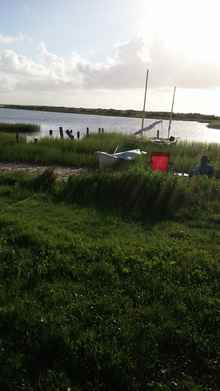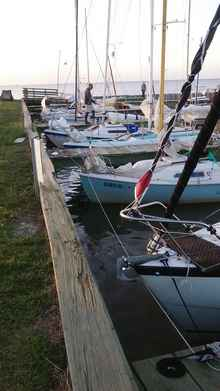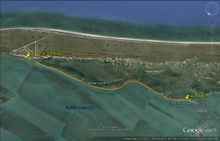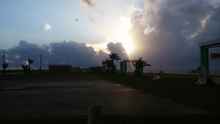
 Custom Search
|
| boat plans |
| canoe/kayak |
| electrical |
| epoxy/supplies |
| fasteners |
| gear |
| gift certificates |
| hardware |
| hatches/deckplates |
| media |
| paint/varnish |
| rope/line |
| rowing/sculling |
| sailmaking |
| sails |
| tools |
| join |
| home |
| indexes |
| classifieds |
| calendar |
| archives |
| about |
| links |
| Join Duckworks Get free newsletter CLICK HERE |
|
|
| A Small Effort – Rowing the 2015 Texas 200 |
by Kelly Davis - Dallas, Texas - USA and, Chuck Pierce - Port Arthur, Texas - USA |
Part 6 part 1 - part 2 - part 3 - part 4 - part 5 - part 6 Army Hole has a docking area shaped like a U. Wind pushes you hard down one leg of the U then you hope to burn speed and energy making the 180 into the docks. That didn’t always work. Splinters and bowsprits were sacrificed. The first sailboat to arrive was a Hobie trihull kayak type rig with a single sailor, no crew. He slid in from the direction I had come, not from to the NW of Army Hole as many were expected to come from. Sitting under Gordo’s shade sipping cold beer we watched the other sailboats flogging dead upwind to AH. The first 3 monohulls to arrive were MacGregors. As much as we had been discussing the expected first boats, a MacGregor had not been mentioned. This was certainly a testament to the fine sailors aboard as well as the usefulness of the 25 and 26 in the TX200. I was able to get a shower in the open air shower before everyone else showed up. Meeting many of the friends I’d made in the previous attempt in 2014 was a high point of the trip. Brian Graham and his dad made me a welcome member of their campsite. I met Pehr, Matt, Chuck and Jack again from last year. I also, met Chris, Leah and Molina bringing their outboard powered shanty boat on the TX200.
Fiddler crabs, I had to mention this. Walking down to the rip rap at end of the docks, the ground was moving, I had to stop and focus on the ground. There were thousands upon thousands of fiddlers moving and migrating about, en mass. It was an awesome sight to behold. The tales of rattlesnakes on Matagorda Island weren’t lost on me. Walking through the tall grass was done slowly and gingerly. I placed my sleeping gear on top of the picnic table. There was a lot of discussion of the route for the final push to Magnolia Beach. Everyone had their favorite route or their own reasoning for why they were going as they were. My thought was to row in a relative wind shadow until almost due N of the Matagorda Island lighthouse then turn downwind to Falwell Island, skirt the east side then slide downwind to Grass Island skirting to east before reaching it. This would put me near the opening of Saluria Bayou. Go east through bayou, turn north at the end and run downwind to Magnolia Beach was the plan. All were up and stuffing gear in dry bags with excitement at sunrise. It was 24 Miles to Magnolia (Maggie) Beach. Everybody was packing some, most cooking breakfast. A few discussions were had regarding the route for the day. Some were going to run downwind to the ICW then eastward out through the jetties into Lavaca Bay then run downwind to Maggie Beach. Others were planning their own individual attack on Saluria Bayou.
Walking back to my picnic table where I had planned to do the espresso and oatmeal breakfast, Glenn and Brian Graham asked me over and cooked up some pancakes and coffee for me on their Coleman stove. They even threw in some bacon. It took about three sentences from Glenn before he asked me if I knew Jesus Christ. I really enjoyed spending time with them, assuring Glenn I did. I’m a strong believer in “plan the row and row the plan”. The plan I had yesterday will be a go. Rowing perpendicular to the wind isn’t my favorite thing to do, especially in a technical section. But when in Rome, follow the chariots. Watching the fishermen in powerboats led me to the opening of Saluria Bayou and I was able to stay on the relatively smooth water in the bayou. Four other TX 200 boats reached the bay about the same time I did and turned north. The wind was pushing me in northward. The size of the rollers were pretty big as I was approached the east end of the Port O’Connor Jetties. Brian boat sailed within shouting of distance his dad’s. As I reached the end of the jetties they jibed and headed north. This last day was going to be a breeze, Maggie Beach, due north, downwind.
Or so I thought. The waves were not consistent and it was hard to gain any speed on the front slope of the waves. Waves coming across the bay seemed to be reflecting back from the shore to my left stacking up into chop. Waves turned into unorganized chop about 2-3’ high. It was a constant struggle to maintain any heading and forward progress. Forget feathering the oars, as they were in the water at different times. The hull was rolling as it slid up and down the chop coming from the sides. While one oar was biting in the water the other would have been lifted to wave in the air. No rhythm. Definitely this was my toughest day on the water. I think I may have been defeated had this been day one or two. Barn sour now, nothing was going to stop me from getting to the finish. All the sailboats had passed me by now. Looking at the bright side, the shrimp will be ready and the beer cold. Rain clouds would form close by, dump on me, then the sun would be out again. It rained on me 3 times before I reached the finish. That last turn to my right to pull up on the beach was a great feeling. A few hard pulls and I would be on the beach. 2:30PM. The landing was exactly as I had hoped it would be. A quiet, landing allowed me to stumble out of the boat with few people looking on. I got my bearings, straightened up and looked around. There were three or four people coming up saying congrats and talking about their trip. I pulled the skiff as far up onto the beach I could, not wanting to lose it now for sure. I was very tired, I couldn’t believe how tired. All I could focus on was walking up to the picnic table that had the Texas 200 Finish Line banner on it. I said a few Howdy’s and searched out Chuck Pierce and Chris Breaux for a finish line photo.
After a few plates of boiled shrimp and a few cold brews, I looked around to see who and what was where. The schooner was being folded. The Bobcat was placed neatly on its trailer. Jack gave me a ride up to the Shell station where my car and trailer were. I love it when a plan comes together. I had finished what I had set out to do; I’d reached my goal of rowing the Texas 200, something that had never been done. Others had rowed farther along the coast and across the Atlantic, but this was mine. The time for recovery and packing for the trip home was here. I showered and planned on spending Sat night here on the beach and then driving up to Galveston to meet Andy Green on Sunday. Andy is the gentleman who conceived the tooling and the Kevlar St. Lawrence skiff that carried me this past week. He is quite the pioneer when it comes to composites and uses. I had been introduced to him by email earlier in the summer by John Mullen, who had originally introduced me to the St. Lawrence skiff. But, this leads to other stories to come.
The End |
To comment on Duckworks articles, please visit one of the following:
|
 |










